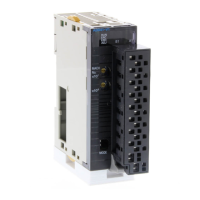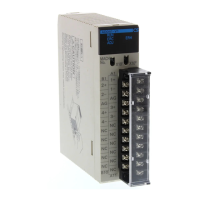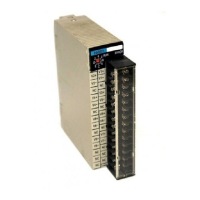Do you have a question about the Omron CJ1M-CPU21 and is the answer not in the manual?
Identifies target personnel for the manual, requiring knowledge of electrical and FA systems.
Emphasizes operating products as specified and consulting OMRON for critical applications.
Crucial warnings about PLC operation, memory modification, and handling electrical components to prevent injury.
Guidelines on avoiding hazardous locations like direct sunlight, extreme temperatures, or corrosive environments.
Precautions for system setup, grounding, power supply handling, and component mounting during operation.
Details on compliance with EMC and Low Voltage Directives for safe system integration.
Overview of CJ1M CPU Units' high-speed, advanced, micro-sized PLCs with built-in I/O.
Details on functional improvements from unit version upgrades for CJ1M CPU Units.
Categorization of built-in I/O functions based on their specific purpose.
Mapping of physical inputs to internal addresses and their functional assignments.
Mapping of physical outputs to internal addresses and their functional assignments.
Details on I/O points utilized by the origin search function for pulse outputs.
Electrical and functional specifications for built-in inputs and outputs, including voltage and current ratings.
Information on connector pin allocations and wiring methods for system connections.
Practical illustrations of various I/O connection configurations for different devices.
Allocation of memory words and bits for built-in I/O usage.
Configuration parameters within the PLC for managing built-in I/O functionality.
Allocation of auxiliary area words and bits related to built-in inputs and outputs.
Explanation of how flags change relative to pulse output operations and timing.
Controls operations for high-speed counters and pulse outputs, including starting/stopping and PV changes.
Reads Present Values (PVs) and status information for high-speed counters and pulse outputs.
Converts pulse frequency to rotational speed or total revolutions.
Registers comparison tables and performs target or range comparisons for high-speed counter PVs.
Sets output pulse frequency and starts pulse output without acceleration/deceleration.
Sets the number of output pulses for SPED(885) or ACC(888) in independent mode.
Outputs specified pulses with acceleration/deceleration, supporting target changes.
Outputs pulses with specified acceleration/deceleration rates, supporting mode changes.
Performs origin search or origin return operations using specified methods and parameters.
Generates PWM pulse outputs with a specified duty factor and frequency.
Detailed description of the types, allocations, and specifications of built-in inputs.
Detailed description of the types, allocations, and specifications of built-in outputs.
Detailed explanation of origin search and return operations and their parameters.
Practical examples illustrating the programming of built-in output functions.
Identifies target personnel for the manual, requiring knowledge of electrical and FA systems.
Emphasizes operating products as specified and consulting OMRON for critical applications.
Crucial warnings about PLC operation, memory modification, and handling electrical components to prevent injury.
Guidelines on avoiding hazardous locations like direct sunlight, extreme temperatures, or corrosive environments.
Precautions for system setup, grounding, power supply handling, and component mounting during operation.
Details on compliance with EMC and Low Voltage Directives for safe system integration.
Overview of CJ1M CPU Units' high-speed, advanced, micro-sized PLCs with built-in I/O.
Details on functional improvements from unit version upgrades for CJ1M CPU Units.
Categorization of built-in I/O functions based on their specific purpose.
Mapping of physical inputs to internal addresses and their functional assignments.
Mapping of physical outputs to internal addresses and their functional assignments.
Details on I/O points utilized by the origin search function for pulse outputs.
Electrical and functional specifications for built-in inputs and outputs, including voltage and current ratings.
Information on connector pin allocations and wiring methods for system connections.
Practical illustrations of various I/O connection configurations for different devices.
Allocation of memory words and bits for built-in I/O usage.
Configuration parameters within the PLC for managing built-in I/O functionality.
Allocation of auxiliary area words and bits related to built-in inputs and outputs.
Explanation of how flags change relative to pulse output operations and timing.
Controls operations for high-speed counters and pulse outputs, including starting/stopping and PV changes.
Reads Present Values (PVs) and status information for high-speed counters and pulse outputs.
Converts pulse frequency to rotational speed or total revolutions.
Registers comparison tables and performs target or range comparisons for high-speed counter PVs.
Sets output pulse frequency and starts pulse output without acceleration/deceleration.
Sets the number of output pulses for SPED(885) or ACC(888) in independent mode.
Outputs specified pulses with acceleration/deceleration, supporting target changes.
Outputs pulses with specified acceleration/deceleration rates, supporting mode changes.
Performs origin search or origin return operations using specified methods and parameters.
Generates PWM pulse outputs with a specified duty factor and frequency.
Detailed description of the types, allocations, and specifications of built-in inputs.
Detailed description of the types, allocations, and specifications of built-in outputs.
Detailed explanation of origin search and return operations and their parameters.
Practical examples illustrating the programming of built-in output functions.
| CPU Type | CJ1M |
|---|---|
| Model Number | CJ1M-CPU21 |
| Data Memory Capacity | 32K words |
| Operating Voltage | 24 VDC |
| Operating Temperature | 0 to 55 °C |
| Execution Speed | 0.1 μs (basic instructions) |
| Serial Communication | RS-232C |
| Expansion Capability | Up to 3 expansion units |
| Programming Language | Ladder logic, structured text |
| Built-in I/O Points | No built-in I/O |











